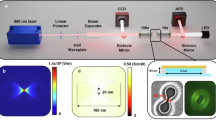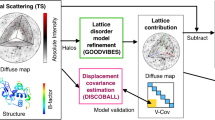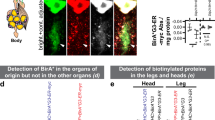Abstract
Using the haem group of myoglobin as a probe in optical experiments makes it possible to study its conformational fluctuations in real time. Results of these experiments can be directly interpreted in terms of the structure of the potential energy surface of the protein. The current view is that proteins have rough energy landscapes comprising a large number of minima which represent conformational substates, and that these substates are hierarchically organized. Here, we show that the energy landscape is characterized by a number of discrete distributions of barrier heights each representing a tier within a hierarchy of conformational substates. Furthermore, we provide evidence that the energy surface is self-similar and offer suggestions for a characterization of the protein fluctuations.
This is a preview of subscription content, access via your institution
Access options
Subscribe to this journal
Receive 12 print issues and online access
$259.00 per year
only $21.58 per issue
Buy this article
- Purchase on SpringerLink
- Instant access to full article PDF
Prices may be subject to local taxes which are calculated during checkout
Similar content being viewed by others
References
Frauenfelder, H., Petsko, G. & Tsernoglou, D., X-ray diffraction as a probe of protein structural dynamics. Nature 280, 558–563 (1979).
Frauenfelder, H. & Wolynes, P.G., Where the physics of complexity and simplicity meet. Physics Today 47, 58–64 (1994).
Frauenfelder, H., Sligar, S.G. & Wolynes, P.G. The energy landscapes and motions of proteins. Science 254, 1598–1603 (1991).
Ansari, A. et al. Protein states and proteinquakes. Proc. natn. Acad. Sci. U.S.A. 82, 5000–5004 (1985).
Zollfrank, J., Friedrich, J., Vanderkooi, J.M. & Fidy, J. Conformational relaxation of a low-temperature protein as probed by photochemical hole burning. Biophys. J. 59, 305–312 (1991).
Thorn Leeson, D. & Wiersma, D.A. Low-temperature protein dynamics studied by the long-lived stimulated photon echo. J. phys. Chem. 98, 3913–3916 (1994).
Jankowiak, R. & Small, G.J. Hole-burning spectroscopy and relaxation dynamics of amorphous solids at low temperatures. Science 237, 618–625 (1987).
Wiersma, D.A. & Duppen, K. Picosecond holographic-grating spectroscopy. Science 237, 1147–1154 (1987).
Narasimhan, L.R. et al. Probing organic glasses at low temperature with variable time scale optical dephasing measurements. Chem. Rev. 90, 439–457 (1990).
Friedrich, J. Hole burning spectroscopy and physics of proteins. Meth. Enzym. 246, 226–259 (1995).
Friedrich, J., Gafert, J., Zollfrank, J., Vanderkooi, J.M. & Fidy, J. Spectral hole burning and selection of conformational substates in chromoproteins. Proc. natn. Acad. Sci. U.S.A. 91, 1029–1033 (1994).
Gafert, J., Friedrich, J., Vanderkooi, J.M. & Fidy, J. Structural changes and internal fields in proteins: A hole-burning Stark effect study of horseradish peroxidase. J. phys. Chem. 99, 5523–5527 (1995).
Littau, K.A., Bai, Y.S. & Fayer, M.D. Time evolution of non-photochemical hole burning linewidths: Observation of spectral diffusion at long times. Chem. Phys. Lett. 159, 1–6 (1989).
Hu, P. & Walker, L.R. Spectral-diffusion decay in echo experiments. Phys. Rev. B 18, 1300–1305 (1978).
Bai, Y.S. & Fayer, M.D. Time scales and optical dephasing measurements: Investigation of dynamics in complex systems. Phys. Rev. B 39, 11066–11084 (1989).
Thorn-Leeson, D. & Wiersma, D.A. Real time observation of low-temperature protein motions. Phys. Rev. Lett. 74, 2138–2141 (1995).
Shibata, Y., Kurita, A. & T Non-Lorentzian hole shape induced by spectral diffusion in H2-protoporphyrin substituted myoglobin in Spectral Hole-Burning and Related Spectroscopies: Science and Applications (Optical Society of America, Washington). 15, 80–83 (1994).
Kurita, A., Shibata, Y. & Kushida, T. Two-level systems in myoglobin probed by non-Lorentzian hole broadening in a temperature-cycling experiment. Phys. Rev. Lett. 74, 4349–4352 (1995).
Meijers, H.C. & Wiersma, D.A. Low temperature dynamics in amorphous solids: A photon echo study. J. chem. Phys. 101, 6927–6943 (1994).
Author information
Authors and Affiliations
Rights and permissions
About this article
Cite this article
Leeson, D., Wiersma, D. Looking into the energy landscape of myoglobin. Nat Struct Mol Biol 2, 848–851 (1995). https://doi.org/10.1038/nsb1095-848
Received:
Accepted:
Published:
Issue date:
DOI: https://doi.org/10.1038/nsb1095-848
This article is cited by
-
Polychronous kinetics with nonstationary rate constants. Effect of a medium
Russian Chemical Bulletin (1997)



